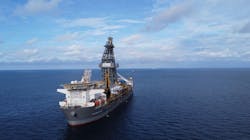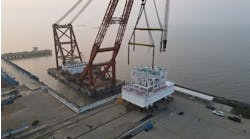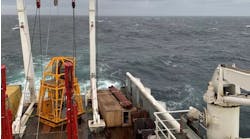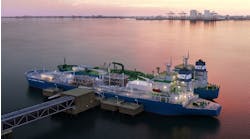Arrival of eighth-generation drillships to the Gulf heralds new era in HP/HT drilling
Editor's note: This Vessels/Rigs column first appeared in the May-June issue of Offshore magazine. Click here to view the full issue.
By Bruce Beaubouef, Managing Editor
The era of high-pressure, high-temperature development in the Gulf of Mexico has arrived. After years of research, study, investment, and field experimentation, the technology has been developed that enables offshore drillers to take on challenging HP/HT fields.
Transocean has been the clear leader in this arena with the arrival of its eighth-generation drillships the Deepwater Atlas and the Deepwater Titan to the Gulf last year.
The Deepwater Atlas and Deepwater Titan are the world’s first eighth generation ultra-deepwater drillships and only rigs to feature a three-million-pound hook-load. Importantly, these drillships also include the first 20,000 psi well control system, a feature that has important implications for deepwater Gulf of Mexico development.
High-pressure, high-temperature reservoirs have been a challenge for Gulf E&P for the past decade or more. Overcoming the HP/HT challenge, at least on the drilling front, stands to be hugely important for the US Gulf of Mexico as a producing region going forward.
Recently, Offshore spoke with Marijana Sosic, Manager, Technical Marketing, with Transocean. She offered some thoughts about the capabilities of the new rigs, and what they mean for Gulf of Mexico and deepwater development going forward.
Offshore: Can you talk about how these rigs came to be, and their origins?
Sosic: While Deepwater Atlas and Deepwater Titan were originally ordered in 2014 just before the industry downturn, these two projects shifted in 2018 when one of our customers approached us with an opportunity to design and construct a rig capable of drilling in 20,000 psi environments – the new frontier of ultra-deepwater drilling. As a result of the new rig design and construction management contract, and a five-year drilling contract, we shifted gears and got to work to accomplish the design, construction and delivery requirements set forth in the construction contract.
As a result of these design changes, both the Deepwater Atlas and Deepwater Titan became the first of their kind – eighth-generation drillships – offering 20,000 psi well control capabilities and a 3.4-million-pound hoisting capacity, the highest rated equipment in the industry. This newest generation of ultra-deepwater drillships will allow Transocean, and its customers, to access high pressure and high temperature reservoirs that previously were not accessible. The equipment on our newest drillships, in addition, can reduce the time it takes to drill a deepwater well, bringing total costs down for our customers.
For context, seventh-generation rigs offer 2.5-to-2.8-million-pound hoisting capacity, and 15,000 psi well control systems, while operating in water depths up to 12,000 feet. Sixth-generation rigs offer a hoisting capacity of up to 2.0 million pounds and are rated for water depths up to 10,000 feet.
Offshore: Can you elaborate on how the equipment on the two drillships is specifically designed to drill and complete these HP/HT wells?
Sosic: Transocean’s eighth-generation drillships are the only two assets in the world specifically designed to maximize efficiencies for 20,000 psi well completions. The vessels and marine risers have been outfitted for 20,000 psi well control capability, including cement systems, integral hull piping, and riser choke and kill auxiliary lines. The Deepwater Titan is outfitted with two 20,000 psi BOPs, while the Deepwater Atlas is outfitted with two 15,000 psi BOPs, one of which will be replaced with a 20,000 psi BOP later this year. Both rigs possess a 3.4-million-pound hoisting capacity. To provide this hoisting capability, upgrades had to be made to the derrick structure and a new active heave compensating drawworks, the highest-rated in the world, top drives and rotary tables were installed. Increased hoisting capacity will provide our customers with numerous cost and time-saving opportunities, especially when drilling programs and well configurations, such as HP/HT wells, require the handling of heavy, large-diameter casing strings.
Well control equipment upgrades to safely access 20,000 psi reservoirs were required and an industry first 20,000 psi BOP was engineered (prototyped), built and installed, as well as the 20,0000 psi rated choke manifolds designed for high pressure drilling, cement manifolds and cementing unit, and associated riser string modifications. This equipment was designed and delivered specifically for these projects – marking new firsts, not only for Transocean, but for the entire industry.
Offshore: What does the arrival of these two drillships mean to GoM development going forward? To ultra-deepwater drilling?
Sosic: Given that Deepwater Atlas and Deepwater Titan are the only two eighth-generation assets in the world, we are quite excited about the expanding list of opportunities requiring the extraordinary capabilities of these rigs.
Transocean has a long history of introducing new technologies that enable our customers to safely and efficiently access the world’s most challenging reservoirs. We are proud to be adding to that history by delivering the industry’s first two rigs capable of drilling and completing wells requiring subsea equipment rated to 20,000 psi and offering the industry’s highest hookload capacity. We are extremely excited about the initial campaigns in the Gulf of Mexico for the Deepwater Atlas and the Deepwater Titan, and look forward to continuing to deliver safe, reliable and efficient drilling operations for all our customers across our global fleet.




